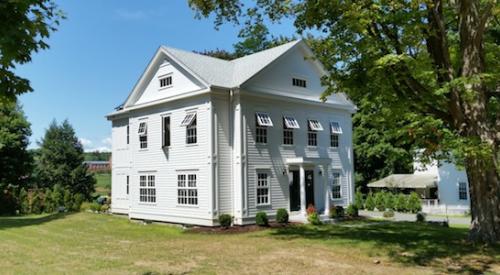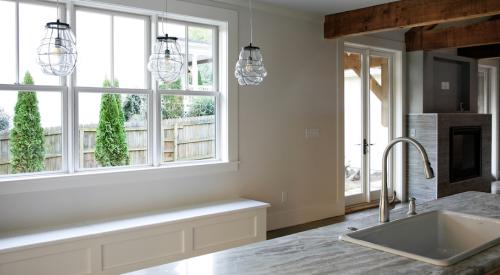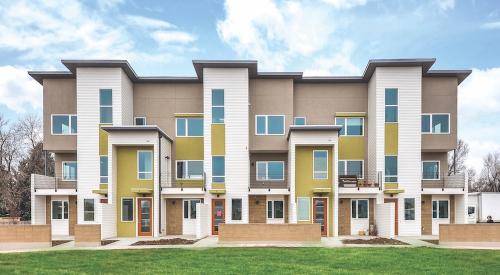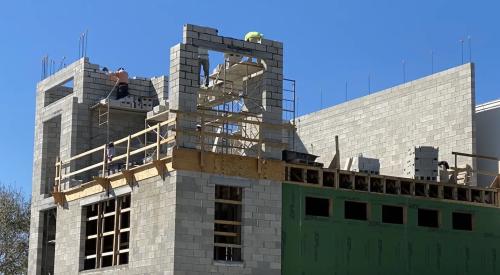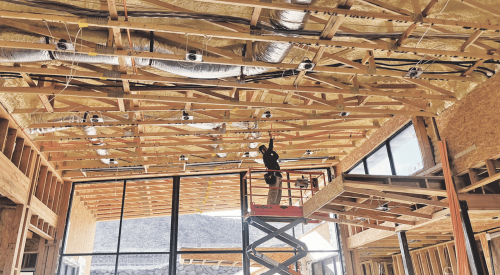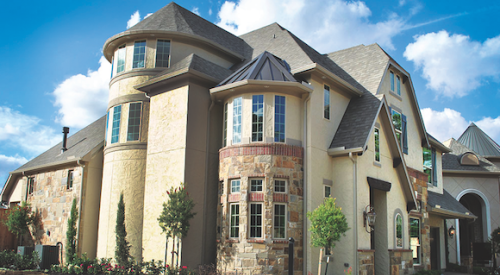Delivering cost-efficient homes isn’t only an upfront proposition these days. More than ever, buyers want a home that offers value every day, and for many homeowners, energy efficiency defines value.
| EVHA Builder of the Year, Medallion Homes, uses energy efficiency as the company’s sales advantage in the competitive new-home market in San Antonio. |
Builders are the energy experts. More than anyone else, builders know how to integrate energy and resource efficiency into the design, construction and marketing of their new homes. No group is better at this than the recipients of the 2000 Energy Value Housing Awards, a pro- gram of the NAHB Research Center, the National Renewable Energy Laboratory and the U.S. DOE that recognizes builders who understand that energy efficiency is a priority today. This year’s 12 gold and eight silver winners set the example for the rest of the industry and answer today’s savvy home buyer’s cry for energy efficiency in the new-home market.
Systems Approach
| Enviro Solar Homes’ standing seam metal roof contains a low-profile, integrated photovoltaic system for solar-generated electricity |
Though this year’s winning homes differ in design, type, price and location they all share one important characteristic--the builders use a systems approach to building design and construction. How to heat and cool the home isn’t an afterthought; it is studied and planned for at the outset. Most EVHA award-winning builders perform a pre-construction energy analysis to evaluate the cost-effectiveness of energy upgrades, and conduct post-construction testing of the homes and ductwork to confirm air tightness.
This year’s winners incorporated energy efficient features such as high-performance insulation, windows and doors; air sealing packages; heat recovery ventilation; resource efficient building materials and diagnostic testing. Some also employ innovative technologies and processes. Examples include:
| A frost-protected shallow foundation, at just 16 inches deep, is insulated around the perimeter with R-10 rigid foam. |
Design and construction are only half the job, however. Building energy efficient homes is step one; marketing that value to buyers closes the loop. Many winning builders create a niche market through creative advertising and customer education. "Our cost of building increases only one or two percent, but the buyers’ perceived value is much higher."
| This house, built by Bill Eich Construction Co., uses Icynene spray foam insulation in the walls and on the flat and cathedral ceilings. |
For a better understanding of the techniques--both technological and marketing--used by EVHA builders, let’s take a look at the winners. In the hot-climate region, technologies common to gold winners include:
| Dominion Building Group’s home features an unvented crawl space built with insulating concrete form walls. |
| A boiler delivers hot water and heat via an in-floor radiant heating and forced air hydronic heating. |
In the custom home category, Pruett Builders’ 3912 square foot home in Sarasota, Fla., includes an energy-efficient, horizontal axis washer that uses less hot water than conventional washers. Compact fluorescent light bulbs were installed in all permanent fixtures and table lamps. The home is also an American Lung Association Health House, and an Energy Star home.
| Engineered wood is a common feature in the EVHA winning homes |
Tierra Concrete Homes received a gold EVHA award in the innovative home category. The company’s extensive use of concrete makes its homes act much like a storage device--holding daytime solar heat for nighttime use. In addition, the use of precast concrete walls reduced waste at the construction site. Because concrete is naturally air tight and the builder takes care to seal areas of potential air infiltration, the winning 2800 square foot home built near Denver resists drafts, resulting in reduced energy use. A raised-heel roof truss allows a thick layer of insulation to blanket entire attic areas, solving the common problem of compressed insulation at attic edges. At the other end, an innovative frost-protected shallow foundation minimizes heat loss to the ground.
Dominion Building Groups’ custom home was constructed of insulating concrete forms. The company spends time in the construction planning stages to carefully size all mechanical equipment and ductwork. While this practice requires a little extra upfront work, it often reduces initial costs if equipment can be downsized.
| Insulation installation at Valley Manufactured Housing is carefully inspected. |
All of Valley’s homes meet or exceed the specifications of the Super Good Cents program, a HUD-code manufactured energy efficiency program, and qualify for energy efficient mortgages.
At Chisholm Creek Development, gold winner in the affordable category, special attention is paid to ensuring a tight building envelope. For example, Chisholm Creek Development does not specify recessed lighting fixtures, which are a common source of air leakage. The winning home underwent a performance test, conducted by the local utility, which subsequently guarantees heating and cooling costs for the geothermal home.
To help buyers understand the benefits of its energy efficient homes, Chisholm Creek mails a series of creative postcards to consumers, and in partnership with a local utility, conducts training seminars for realtors and appraisers.
Managing heating costs in cold climates is a particular challenge for builders and homeowners alike. This year’s EVHA winners combine building systems and consumer education to ensure a cost-effective home long term.
Controlling leakage from ductwork is a universal practice among these builders. All run heating and cooling distribution systems in conditioned spaces and seal the ducts with mastic--if they use ducts, that is. Radiant floor heating was the preferred distribution choice in the custom and innovative home category.
Hall Quality Homes’ winning affordable home features R-19 basement walls, R-10 slab perimeter insulation, R-21 walls, R-44 attic insulation and R-14.5 doors. The company’s use of a frost-protected shallow foundation permitted the foundation to be constructed only three feet below grade. To ensure that the built-in energy-saving features deliver the intended benefit, regular site inspections are made to document proper installation.
In the custom home category, Bill Eich Construction Company’s award-winning home also features a frost-protected shallow foundation that, at just 16 inches deep, is insulated around the perimeter with R-10 rigid foam. Two inches of rigid foam insulation located 12 inches below the slab further insulate the foundation.
Walls are insulated with Icynene spray foam, plus one inch of rigid foam board. Flat ceilings are insulated with Icynene and blown cellulose for a total R-value of 53, while cathedral ceilings are insulated with the same material to R-37.
Gimme Shelter Construction’s winning innovative home features a geothermal heating system that is equipped with a desuperheater for energy-efficient water heating. The home is oriented to take advantage of the sun for additional heating while overhangs are sized to maximize winter solar heat gain and summer shading.
A special wall design produces a 7 inch wall cavity that accommodates a thick layer of insulation while R-50 blown cellulose insulation blankets the attic. The home also includes a vapor-barrier that is taped, sealed and augmented with airtight electric boxes for continuity. To complete the package, a heat recovery ventilator ensures a continuous supply of fresh air inside while reclaiming heat from exhaust air.
Every year Watt Homes, a division of WL Homes, builds more than 200 houses that meet the specifications of its award-winning entry in the production category. Using blown cellulose in all walls with rigid exterior foam board, Watt builds R-20, 224 above-grade walls. Raised-heel roof trusses permit R-45 blown cellulose insulation to cover the entire attic.
Watt’s advertisements demonstrate its commitment to energy efficiency, explaining to new home buyers about various energy-saving features and including a checklist of all the efficiency features that are standard in a Watt home.
For more coverage of the award winners visit www.housingzone.com. To get a 2001 entry form go to www.nahbrc.org.
Also See:
EVHA Builder of the Year: Medallion Homes
EVHA Silver Award Winners
